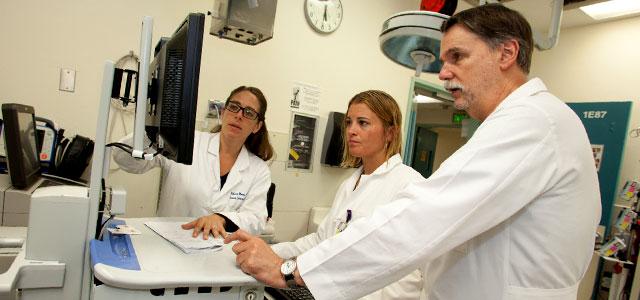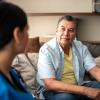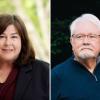
Brigid Donovan (center) at San Francisco General Hospital with Rebecca Menza (left) and Bob Mackersie, director of the trauma service (photo by Elisabeth Fall)
ACNPs, San Francisco General and the Asiana Crash
Brigid Donovan is a 2007 graduate of the Acute Care Nurse Practitioner (ACNP) program at UC San Francisco School of Nursing. Since December 2007, she has been an ACNP for the trauma and general surgery service at San Francisco General Hospital.
It was already a busy morning for the trauma service. We start daily rounds at 6:30 a.m., but that day, the “900” trauma activations on our pagers had brought us to the emergency department (ED) numerous times by 10:00 a.m., interrupting our daily flow of rounds. However, we continued to round together as a team – nurse practitioners (NPs), attending trauma surgeon and residents – until about 11:45, when we heard about a confirmed commercial plane crash at SFO. It was unclear how severe the crash was or how many people were injured, but the Mass Casualty Incident was activated over our pager system. The trauma team – which that morning consisted of three NPs, two interns, one attending trauma surgeon and two surgical residents – headed to the emergency department.
The first wave – the most critically injured patients – arrived about 15 minutes later. Three of these patients went directly to the OR due to the severity of their injuries. Shortly thereafter, two or three more waves of patients arrived. Four NPs – Rebecca Menza (a 2006 ACNP graduate and an assistant clinical professor at UC San Francisco School of Nursing), Genell Hilton (an FNP), Danielle Berthold (a 2007 Adult Nurse Practitioner graduate) and I – worked with our ED and trauma colleagues to triage all of these patients. We were in the trauma rooms performing primary and secondary surveys, and ordering radiographic images, labs and blood products. We were calling consulting services, writing admission orders, coordinating the transfer of patients and communicating with our ED/ICU/ward charge nurses and the nursing administrator on duty to ensure that all patients had been examined and transferred and/or admitted to the appropriate level of care. A few times throughout that day I assisted nurses with the massive transfusion of blood products. I think our trauma team examined around 50 patients from the crash and admitted about 20 of these patients to our trauma service. Other clinicians, not on duty that day, had heard the news and arrived at the hospital to help.
When things started to quiet down a bit, six hours after the first crash victims arrived, numerous radiologists, orthopedic surgeons, neurosurgeons, plastic surgeons, trauma surgeons, emergency room physicians, intensivists, residents, NPs and hospital administrators congregated in one room. We reviewed every patient – looked at radiographic imaging and discussed injuries, plan of care and disposition. It was an amazing example of how people can come together and do what’s right in the moment.
 Asiana Airlines plane crash at San Francisco International Airport, July 6, 2013 (photo courtesy of Wikimedia Commons) Still, after that first 24 hours, many of these patients, especially those in the ICU, remained very, very sick. A few had already been back to the operating room more than once. As NPs for the trauma service, we are first call for all of our inpatient service including the ICU. I happened to be scheduled as the ICU NP on the day of the crash and the three days thereafter, and it was an intense environment, managing the overall care of these injured patients, especially with the census so high. NP shifts are usually 12 hours, from 6 a.m. to 6 p.m., but those days it didn’t feel right to leave the hospital at 6 p.m. A few of us worked until 10 or 10:30 p.m. the night of the crash and in the days that followed.
Asiana Airlines plane crash at San Francisco International Airport, July 6, 2013 (photo courtesy of Wikimedia Commons) Still, after that first 24 hours, many of these patients, especially those in the ICU, remained very, very sick. A few had already been back to the operating room more than once. As NPs for the trauma service, we are first call for all of our inpatient service including the ICU. I happened to be scheduled as the ICU NP on the day of the crash and the three days thereafter, and it was an intense environment, managing the overall care of these injured patients, especially with the census so high. NP shifts are usually 12 hours, from 6 a.m. to 6 p.m., but those days it didn’t feel right to leave the hospital at 6 p.m. A few of us worked until 10 or 10:30 p.m. the night of the crash and in the days that followed.
Though we deal with mass casualties and injuries like this all the time at SF General, I’ve never experienced anything of the magnitude of this crash, and it actually became an emotional experience for me. For one, many people filtered through the hospital and ICU in those first 24-48 hours: patients, doctors, nurses, hospital administrators, homeland security officers, airline representatives and local and state government officials. But I was most affected when patients had been identified and families began arriving. Those initial family meetings were tough.
Despite the magnitude and level of activity, it’s amazing that there wasn’t a lot of chaos. Arriving patients were triaged and the entire response was organized incredibly well, which is a real tribute to our hospital and the entire staff at San Francisco General. Everyone pitched in to help in any way that they could that day; this kind of disaster is what we prepare for as a level I trauma center. I feel very lucky and proud to have been part of such a wonderful team at SFGH. There was no better place for any of these plane crash victims to come.



